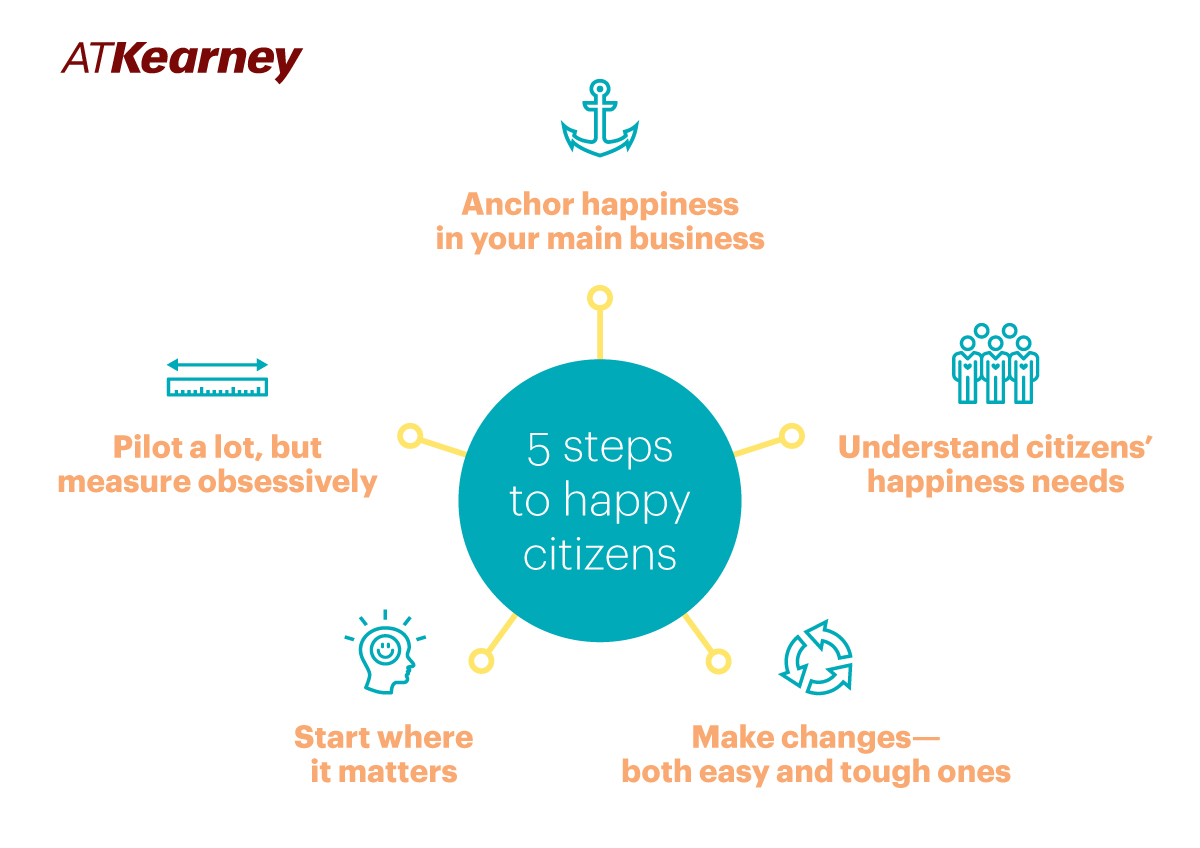What are 5 Steps to Happier Citizens
More governments are getting into the happiness business
A few years ago, the idea that government was responsible for the “happiness” of its citizens would elicit raised eyebrows. Happiness, after all, was too delicate a topic to arise from the dispassionate halls of government bureaucracies. Since then, many countries have actively pursued ways to increase the happiness and wellbeing of their citizens. In the UAE, the Minister of Happiness launched an ambitious national happiness agenda that includes tools to gauge citizen satisfaction and fulfillment. The UK recently appointed a Minister for Loneliness to address the social isolation of some 90 million citizens.
Today, governments are expected to place the happiness and wellbeing of their citizens at the top of their policy agendas, by a society that is increasingly obsessed with happiness—defining it, capturing it, and maintaining it. Consider the 75 million hits from our recent Google search of the word happiness:
- 2 million visitors to The Happy Show by designer Stefan Sagmeister
- 100,000 books on Amazon relate to happiness
- Billboard’s No. 1 pop song Happy by Pharrell Williams (2014)
- 160 countries participate in the United Nation’s annual International Day of Happiness
This week, as heads of governments, thought leaders, and scientists gather in Dubai for the sixth annual World Government Summit, all eyes are on happiness—specifically, a government’s role in securing happiness for its citizens.
People just want to be happy
Personal happiness, say the professionals, comes from the congruence of four elements: satisfaction of basic needs, joyful daily moments, social relationships, and a sense of a higher purpose and deeper meaning of life. Are governments capable of delivering on these four elements for their citizens? Some are. But many are not as spreading happiness far and wide can be a complex undertaking. “Most people want to be happy but outside forces can lead to challenges that trigger sadness, loneliness, and despair,” explains one official. “Government can have a role in pulling people out from the depths, but it has to be done right.”
5 steps to a happy citizenry
It is not unusual to find significant gaps between the national happiness goals set by governments and the real-life expectations of their citizens. In our experience, bridging this gap requires focusing on agencies that have direct contact with citizens. The following summarizes our five-step approach to a happier citizenry:
Anchor happiness in your main business. A good happiness strategy is aligned to your organizational strategies and performance indicators (KPIs), is supported by measurement tools and incentives, and is tailored to meet the needs of your citizens. The idea is to focus primarily on the outcomes that matter most to people while simultaneously gauging how well an agency is organized to deliver its services (e.g., mobility, utilities, parks and recreation).
Understand citizens’ happiness needs. Government agencies are generally proficient at interacting with customers, employees, and partners and, in most cases, providing a benefit to society. But raising the happiness levels of individual citizens requires a deeper approach, one that better understands the unique needs and expectations of citizens and personalizes experiences across all touch-points and channels. Digitization and tech-driven innovation will be instrumental in “scaling up” personal happiness experiences.
Make changes—both easy and tough ones. Many government agencies struggle with the types of changes required to build real and meaningful happiness experiences. On the surface, the changes may appear to be “cosmetic” (think smiley faces and a friendly customer service counter). In real life, anchoring happiness in the main business calls for an honest evaluation and meticulous re-design of agency policies, processes, IT systems, and organizational culture.
Start where it matters. The best place to begin designing happiness-centric experiences is with your customer-facing employees—focusing on their attitudes and hire-to-retire practices. A happiness-centric attitude combined with the elimination of all customer complaints will deliver the biggest rewards in the shortest amount of time.
Pilot a lot, but measure obsessively. Happiness experiences are built on a willingness to take risks, to try new initiatives, and to pilot programs and solutions. It’s important to begin with measurements for what works and what doesn’t, otherwise you risk being locked into hundreds of happiness initiatives that deliver questionable results. Establishing a robust culture of evaluation and monitoring allows for capturing institutional know how and making quick adjustments.
As more countries seek ways to raise the happiness levels and wellbeing of their citizens, the world will benefit from a cheerier, calmer, and more relaxed populace. And that’s a good thing.
